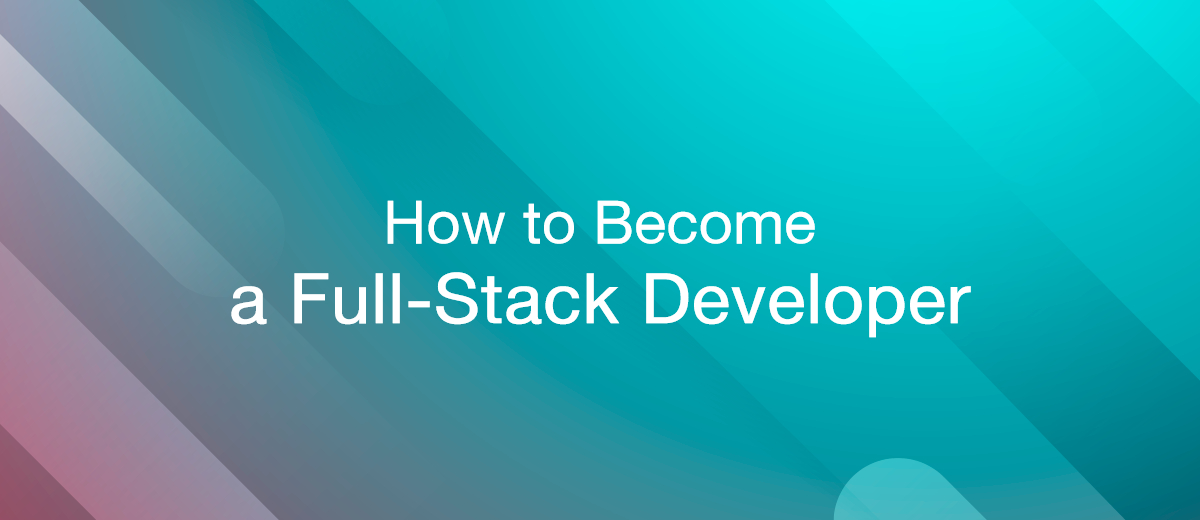How to Become a Full-stack Developer
In today's IT job market, versatile programmers with a high level of training and extensive qualifications are in high demand. They are called full-stack developers. One such specialist can perform the duties of a whole range of IT professions. Thanks to this, these orchestra-like programmers are highly valued and often sought by employers. From our article, you will learn how to become a full stack developer, what this profession entails, what is needed for its mastery, as well as its advantages and disadvantages.
Who is a Full-stack Developer
The essence of a full-stack developer's activity is reflected right for this profession. These are programmers who possess a complete set (full stack) of development technologies. Traditionally in the IT sphere, developers are divided into two categories: frontend and backend, according to their area of responsibility. To put it briefly and simply, frontend developers are responsible for the user-visible interface of the software, while backend developers handle its internal software-hardware part. This classification helps effectively to divide the work areas for optimizing the project execution process.
Over time, a separate caste of programmers emerged who are proficient in the full stack of technologies and can work on both frontend and backend. The stack consists of various programming languages, databases, frameworks, standards, and implementation approaches. For example, to accomplish frontend tasks in web development, you would need HTML, CSS, Bootstrap, JavaScript, and Vue.js. The backend stack for the same project would require knowledge of PHP, Laravel, MySQL/MongoDB, Ruby, and Python. Full-stack developers are renowned for their versatility: they can not only create a website layout, but also set up a server, raise a database, and perform a variety of other diverse tasks.

A full-stack developer fully "assembles" the product: starting from writing code, choosing the optimal architecture, and connecting to servers and databases. In addition, they often maintain it after the release, fix errors, prepare updates, and administer the project. For those looking to expand their team, it might be beneficial to hire web developers who can bring a diverse set of skills to the table. Such versatility has made a widely skilled programmer in high demand in many IT directions: from website and web application development to creating software for PCs, mobile applications, and computer games.
If you are interested in how to become full stack developer, we recommend familiarizing yourself with the complete list of duties that such specialists have to perform. We will discuss them in detail in the next section of the article.
What Does a Full-stack Developer do
Information on how to become a fullstack developer would be incomplete without defining the main job responsibilities of this specialist. However, their versatility makes it somewhat difficult to determine the exact list of functions performed by this wonder-programmer. The content of their task set can be influenced by their knowledge, experience, qualifications, and employer requirements.
In general, if we consider, for example, web development, a full-stack developer's responsibilities include two major groups of tasks:
- Frontend. This involves creating a user interface and other elements of the "external" part of the site – everything that a visitor sees in their browser: buttons, blocks, banners, animation elements, etc. A full-stack developer's frontend tasks also depend on the specifics and scale of the project they are working on. For example, in a large team, they would create a website layout based on prepared designer mock-ups. While working on small indie projects, they often have to perform the work of a web designer.
- Backend. This group includes working with the internal (server) part of the site, which is hidden from the user's view. It is responsible for ensuring fast and stable functionality. This includes "setting up" and configuring servers and databases, as well as other tasks related to ensuring the website's performance and its ability to quickly and error-free process user-entered information.
Full-stack developers are often classified by the programming languages they use. The most popular ones (in the context of web development) are considered to be Node.js, Java, PHP, Python, and ASP.NET.
So, if you have decided to master this profession and want to know how to can I become a full stack developer, first familiarize yourself with the duties you will have to perform:
- Programming the user interface, visual design, and server part of a website/program/game/mobile application.
- Creating web page layouts.
- Preparing the project for release (testing, bug search and debugging).
- Quality control of the project.
- Working with databases, network resources, cloud storage, and file systems.
- Managing current IT projects in a specific programming language: coordinating developers and other specialists, product marketing, creating MVP, managing the product lifecycle, etc.
- Providing technical support to all project participants.
- Implementing and monitoring the implementation of the DevOps methodology: automating the processes of software assembly, configuration, and deployment.
Full-stack developers often need to not only coordinate all specialists in the team but also negotiate with clients, which adds project manager duties to their arsenal as well.
How to Become a Full Stack Developer
One of the first questions that beginners in IT ask when they are interested in this field is, "How do I become a full stack developer?" It is believed that most often, backend developers who are forced to deal with various frontend tasks during the creation of a website/program/app master this specialization. Working on these tasks, they gradually learn frontend development and become full-stack developers.
To fully learn full-stack programming, you first need to thoroughly master one direction and then move on to the opposite side. It is important to consider that to achieve a high-quality result, you should pay attention not only to the quantity of knowledge acquired but also to its depth. Programming beginners often make this mistake, trying to cover the maximum amount of information. In doing so, they learn superficially, which hinders their professional development in the future.
So, if you want to become a full-stack developer, you need to sequentially study frontend and backend development. You can do this through courses or independently. The most effective option is a combination of theory and practice: first, acquire theoretical knowledge and skills, and then apply them in practice. For example, you can implement your own project, in which you will have to perform tasks related to both frontend and backend. In principle, it can relate to any programming field that interests you, from web services to mobile applications. The main thing is that you successfully practice frontend/backend development skills. If the project is successfully completed, it will be the first in your full-stack specialist portfolio.
As for the specific knowledge and skills required for a professional full-stack developer, the following are highlighted:
- Programming languages and technologies for frontend development (Bootstrap, JavaScript, Vue.js, Typescript) and backend (C++, Python, Go, Java, PHP, C#);
- Markup languages for websites and web applications (HTML and CSS);
- Principles of cloud storage operation;
- DevOps methodology;
- Principles of search server operation and configuration;
- System administration;
- Browser compatibility features;
- Frameworks and version control;
- Knowledge of English, at least at the Intermediate level.
For successful professional and career growth, a full-stack developer needs not only to know programming, but also possess a range of soft skills. Among the main ones are:
- Adaptability. The versatility and multifunctionality of these specialists require them to quickly learn unfamiliar technologies and methodologies. They must constantly monitor new IT trends relevant to their specialization and be ready to promptly study and implement them in their work in the shortest possible time.
- Time management. As a rule, full-stack developers have a higher workload compared to specialized programmers. Therefore, it is especially important for them to be able to properly organize the work process, prioritize current tasks, and efficiently distribute their working time among them.
- Communication. Full-stack specialists often perform project manager functions. Consequently, the ability to delegate tasks, coordinate the work of the team, interact with clients and other departments is crucial for them.
- Empathy. Another useful soft skill that helps convey important information to colleagues/clients clearly and tactfully, exchange ideas/proposals, and prevent the emergence of conflicts or a toxic atmosphere within the team.
How Benefits of Being a Full-stack Developer
When talking about how do you become a full stack developer, it is essential to mention the advantages of this profession. There are indeed many benefits, both for the developer themselves and their employers. The main ones include:
- Multifunctionality. Full-stack developers are proficient in various languages, technologies, and development methods, allowing them to see the full picture of a project with all its details and nuances. They are capable of creating complex, multi-stage projects independently, skillfully setting up the interaction between the user and server parts. A comprehensive approach helps avoid inconsistencies between the frontend and backend during both development and project support.
- Demand. The multifunctionality of full-stack developers makes them highly sought-after in the job market. Various employers are interested in such specialists, from large corporations to small startups. They can lead a project's development and coordinate its team from the beginning, or develop a website/program/app/game independently. Thus, one full-stack developer can replace several specialists and save the employer significant resources.
- Versatility. Full-stack developers have vast opportunities for career and professional growth. They can work in companies not only as full-stack, but also as frontend or backend developers. In addition, other employment options are available to them, such as joining a promising startup, taking on interesting/high-paying freelance orders, or starting their own project.
- Variety of tasks. These specialists have a wide range of job duties and functions. They can regularly change the technologies/methods and projects they use. This diversity not only promotes active learning of new knowledge and skills, but also prevents the work process from becoming routine and protects against burnout.
However, the profession of a full-stack developer has not only advantages but also some drawbacks. These include:
- Difficulty and duration of training. Since this profession includes two full-fledged specializations, it takes one and a half times longer to master than frontend or backend development. It is also more challenging for a full-stack developer to grow professionally, as they need to track and learn new technologies in two areas simultaneously.
- Limited knowledge. The need to work in two directions at once prevents the full-stack developer from gaining truly deep knowledge and skills in any of them. In other words, the specialist focuses on the quantity and breadth of their professional knowledge, which may affect the depth and quality.
- High workload. A full-stack developer is a true "universal soldier" who must know and understand much more than other team specialists. As a result, they are assigned the most complex and responsible tasks. They often also take on the role of project manager, coordinating other employees and interacting with management or clients.
- Difficulty in keeping up with new trends. Another drawback emerges from the previous ones. A full-stack developer is required to quickly master all the new IT technologies and trends related to their line of work. However, this can sometimes be challenging. Due to the large number of current tasks/duties, there simply isn't enough time to learn something new.
Let's sum up
The profession of a full-stack developer is best suited for those who prefer to independently control the work on all parts of a project. If you don't like being dependent on colleagues, want to be able to perform almost any task, and your life motto is "If you want something done well, do it yourself," then this is definitely for you.
At the same time, a full-stack developer should not necessarily be able to instantly switch between entirely different activities (finishing server settings, immediately starting to write the connecting software in Java, and then moving on to browser JavaScript) and do it all perfectly. Narrow specializations exist for a reason. However, a versatile developer who has an understanding of the entire stack will undoubtedly create a higher-quality application. That’s why If you're looking to scale your team, hiring a .NET developer with a huge experience can bring valuable expertise and contribute to the success of your projects.
To become such a broadly skilled specialist, first determine the specific direction you want to develop in, and then develop, prepare, and launch a working project from A to Z by yourself. Keep in mind that during the product creation process, you will need to work with both frontend and backend. For example, take on an online ordering service for a store or write an application for storing text files in the cloud.
Time is the most valuable resource in today's business realities. By eliminating the routine from work processes, you will get more opportunities to implement the most daring plans and ideas. Choose – you can continue to waste time, money and nerves on inefficient solutions, or you can use ApiX-Drive, automating work processes and achieving results with minimal investment of money, effort and human resources.

